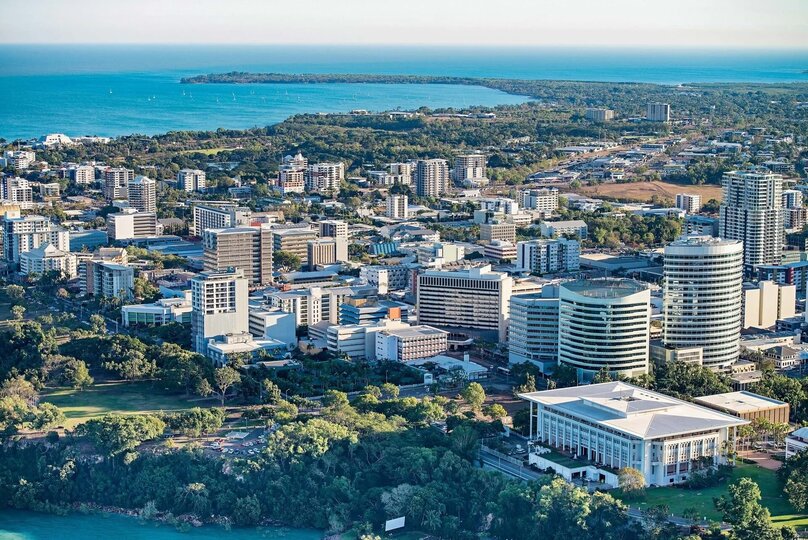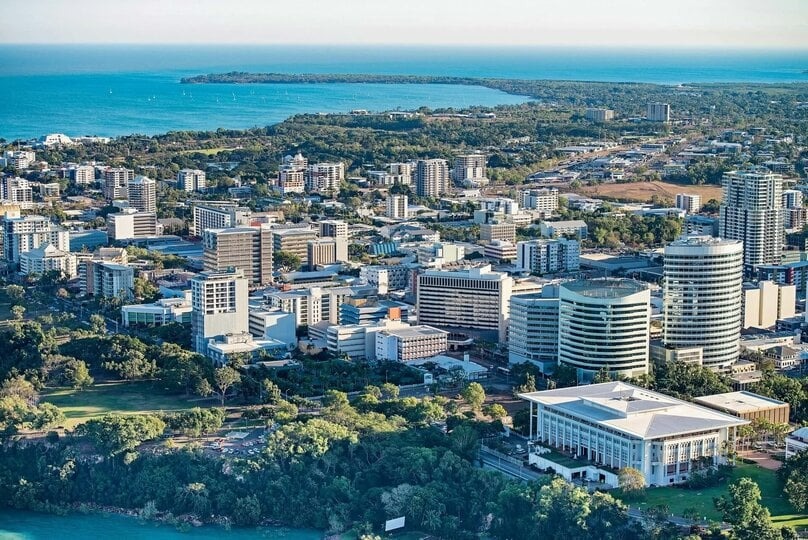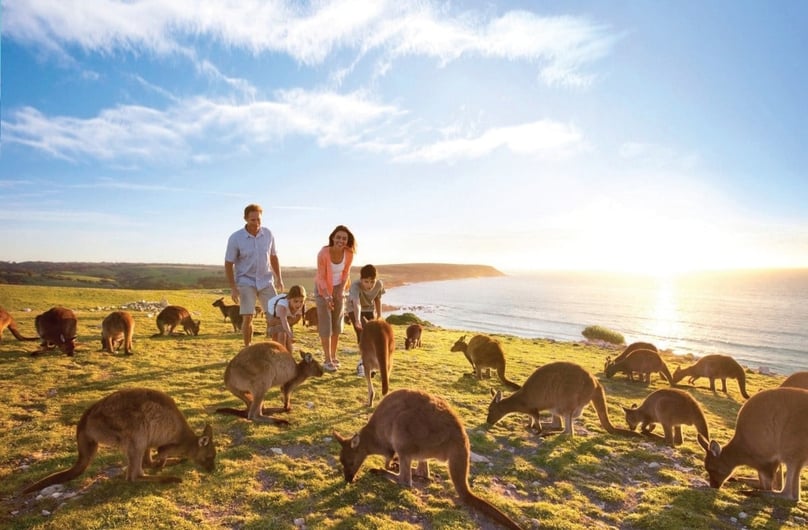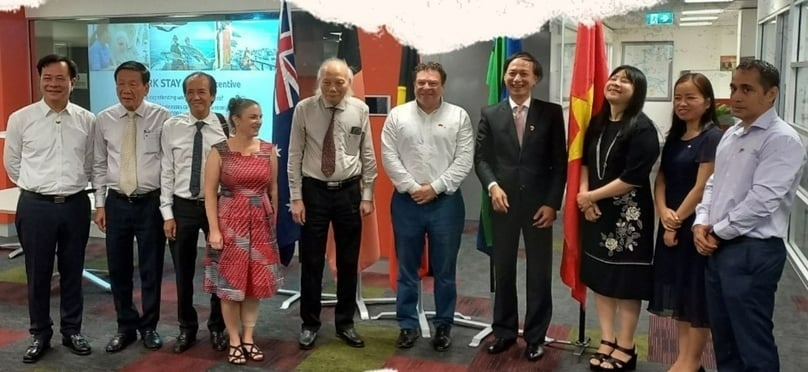
Australia’s Northern Territory - a land of great potential
Australia’s Northern Territory is a land rich in resources, with many favorable conditions for the development of agriculture and tourism. It possesses huge untapped potential, and has high demand for labor and construction materials for infrastructure development.
Untapped potential
On March 5-9, 2024, Prime Minister Pham Minh Chinh paid an official visit to Australia. As the highlight of the visit, the prime ministers of the two countries announced the upgrading of bilateral relations to a Comprehensive Strategic Partnership. This is an important premise for investment cooperation between Vietnam and Australia, including the Northern Territory, to develop to a new level.
Many Vietnamese people, when mentioning Australia, often think of famous cities like Canberra, Sydney, and Melbourne. But in fact, in terms of strategic geographical location, the Northern Territory's capital Darwin plays a unique role as the closest gateway connecting Asia with the rest of Oceania.

Darwin, capital of the Northern Territory. Photo courtesy of Getty Images.
In the past, the foundation of the cooperative relationship between Vietnam and Australia was often associated with official development assistance (ODA), with major projects such as My Thuan and Cao Lanh bridges, both crossing the Tien river in southern Vietnam, as well as technical support for agriculture, climate change, education and training, gender equality, and state governance.
Nowadays, with Vietnam's position, especially under a strategy to promote business and investment cooperation in the Northern Territory, the two sides are cooperating under a win-win mechanism.
The Northern Territory is a land rich in natural resources such as oil and gas and minerals. It boasts Aboriginal cultural heritage and majestic nature reserves.
The Northern Territory is one of six states and territories in the Federation of Australia, and has the highest GDP per capita, with an area four times larger than Vietnam but a population of less than 250,000.
Of the population, immigrants account for over 30%, mainly coming from the Philippines, the UK, New Zealand, India, Greece, the U.S., China and Indonesia. The number of Vietnamese living, studying and working in the Northern Territory is smaller than other large cities such as Sydney or Melbourne.

Its main economic sectors include mining, oil and gas, tourism, international education and training, defense and agriculture. The tourism industry is an important driving force contributing to the development of the Northern Territory.
The Northern Territory’s economy has grown rapidly with the support of key projects. From the 2005-2016, its GDP grew by more than 40%, from $16.2 billion to $23.6 billion. The population increased by 17% to more than 245,000 people, while the workforce rose 34,000 people to more than 140,000.
Northern Australians are experts who know how to tap opportunities available in the arid tropics and are creative and confident with their skills obtained from hardship.
The cultural diversity gives strength to the Northern Territory with up to 30% of the population being Aboriginals compared to the national average of 3%. Aboriginals are the traditional owners of much of the land and coastline in the Northern Territory. Approximately 50% of the land and 80% of the coast are owned by Aboriginal people, recognized by Commonwealth laws and the Aboriginal Land Rights (Northern Territory) Act 1976.

Australia's Northern Territory presents promising opportunities for growth in international education, tourism, minerals, oil and gas, fisheries and agriculture. Photo courtesy of tourguidecourse.com
In addition, the Northern Territory is close to Asia and has good relationships with its northern neighbors. It has a strong competitive advantage in Asia's high-demand manufacturing sector, with promising opportunities for growth in international education, tourism, minerals, oil and gas, fisheries and agriculture.
The Northern Territory government is strong with a long history of strategic investments in infrastructure transformation. In the past, the government has invested in strategically important services and infrastructure such as Darwin Port, AustralAsia Railway, and conference centers in Darwin, Alice Springs, and Darwin University. These investments have played an important role in the economy, society, knowledge, and culture, attracting human resources and investments from the private sector.
The local government has also facilitated private sector investments in key projects like Ichthys - the largest foreign investment project undertaken by Japanese and French investors.
As a gateway to Asia, a key defense hub, a tourist attraction, and a land rich in minerals, gas and oil, and with developed agriculture, the Northern Territory has strategic opportunities to meet the demands of future economic growth. These strategic advantages also provide opportunities for growth in service industries such as health, education, and research.

Nguyen Ngoc My, vice chairman of the Vietnam Association of Foreign Invested Enterprises (VAFIE) and chairman of the Northern Territory-Vietnam Business Council (NTVBC). Photo by The Investor/Trong Hieu.
Vietnam-Northern Territory strategic cooperation
According to Nguyen Ngoc My, vice chairman of the Vietnam Association of Foreign Invested Enterprises (VAFIE) and chairman of the Northern Territory-Vietnam Business Council (NTVBC), since the beginning of 2013, efforts have been made to establish business cooperation relationships between Vietnam and the Northern Territory.
Despite these efforts, cooperation remains far from its potential, especially as Darwin plays an important role as a gateway between Asia and the rest of Oceania, he said.
Therefore, to accelerate the development of the Northern Territory, a cooperation strategy has been developed by the NTVBC, clearly demonstrating specific goals and roadmaps to stimulate growth between the two sides.
"To expand the comprehensive strategic partnership between Vietnam and Australia, we need to take advantage of the differences between the two countries to build a strategy to boost investment, trade, tourism and labor exports in the Northern Territory," he said.
"The territory is home to many Aboriginal people, and much of the land is owned by them, so we should study the characteristics, customs, culture, and interests of Aboriginal people to establish mutually beneficial relationships between them and ethnic minority groups from Vietnam," My added.
Regarding labor, Vetnam need to select and provide vocational and English training for workers and build a team of highly skilled, healthy, and labor-conscious workers to bring to the Northern Territory. In 2021-2025, a program to send 30,000-50,000 Vietnamese workers to the territory will be piloted, with the goal of bringing about 1 million Vietnamese people to work and study in the Northern Territory within 20 years, he noted.
"Regarding agriculture, it is necessary to take advantage of fertile land to grow fruit trees and raise livestock on a large scale, and process agricultural products and foods for export back to Vietnam and other countries. We need to establish a number of agricultural and industrial clusters managed by Vietnamese people, thereby forming Vietnamese villages and communities in the territory," My stated.
In terms of trade, Vietnam's import-export relationship with the Northern Territory is almost non-existent. Labor exports and the formation of agricultural-industrial clusters can create a breakthrough in trade relations between the two sides, contributing to increasing two-way trade turnover between Vietnam and Australia.
Regarding tourism, the Northern Territory has a climate similar to southern Vietnam, with two seasons: the rainy season and the dry season, so the two sides can rapidly expand their tourism links. First of all, they should encourage Vietnamese international travel companies to explore and tap the potential for tourism development in the Northern Territory, piloting the opening of direct flights between Hanoi/Ho Chi Minh City and the Australian territory.
My held that when tourism, trade, investment, and labor exports grow, direct air routes can be established between major cities in Vietnam and the Northern Territory.

Prof. Dr. Nguyen Mai, chairman of the Vietnam's Association of Foreign Invested Enterprises (VAFIE). Photo by The Investor/Trong Hieu.
VAFIE chairman Prof. Nguyen Mai said that a strategy to strengthen Vietnam-Australia economic cooperation has been approved by the prime ministers of the two countries with the goals of becoming top 10 trade partners and doubling two-way investment.
"The successful promotion of Vietnam-Northern Territory cooperation will make an important contribution to the process of realizing these goals," he stressed.
According to Mai, the Northern Territory has an area of more than 1 million square kilometers and many advantages in agriculture, minerals, and tourism, while the population is less than 250,000. Vietnam and the territory have many complementary advantages to cooperate for development on the principle of equality and mutual benefit.
"As an association of foreign businesses investing in Vietnam and Vietnamese businesses investing abroad, we are trying to promote cooperation between Vietnam and the Northern Territory, especially in the fields of human resource training, agriculture, mining, construction, and tourism," the professor said, expressing his hope that Vietnamese workers trained through cooperation programs will be supported by the Australian government to work for investment projects run by Vietnamese enterprises in the Northern Territory.

Vietnam's Prime Minister Pham Minh Chinh and his counterpart Anthony Albanese announced the upgrading of bilateral relations to a Comprehensive Strategic Partnership during the former's official visit ro Australia on March 5-9, 2024. Photo courtesy of the Vietnamese government's news portal.
On March 5-9, 2024, Prime Minister Pham Minh Chinh paid an official visit to Australia at the invitation of his counterpart Anthony Albanese. As the highlight of the visit, the prime ministers of the two countries announced the upgrading of bilateral relations to a Comprehensive Strategic Partnership.
The two PMs agreed to coordinate closely to implement six major orientations, including higher and more strategic diplomatic-political trust; more inclusive, substantive, and effective economic, trade, and investment cooperation, tapping the potential of the two highly complementary economies; promoting stronger cooperation in science-technology, innovation, digital transformation, and green transition; more comprehensive and deeper cooperation in culture, education-training, environment, and climate change response; more open and sincere people-to-people exchanges and connections between generations; and better understanding, sympathy and sharing about security-defense cooperation.
From May 30 to June 5, 2022, Prof. Nguyen Mai and a VAFIE delegation paid a working visit to Australia to explore investment cooperation opportunities between Vietnamese businesses and their peers in Australia, especially the Northern Territory.
During the visit, the VAFIE delegation accompanied Vietnamese Ambassador to Australia Nguyen Tat Thanh to working sessions with leaders of the Northern Territory and businesses to discuss potential investment cooperation opportunities between the two sides.
At the working sessions, both Vietnam and the Northern Territory representatives said that the potential for cooperation between the two sides is huge but seems to be untapped, and pointed out the barriers that need to be removed to turn that potential into a reality.

The VAFIE delegation accompanied Vietnamese Ambassador to Australia Nguyen Tat Thanh to working sessions with leaders of the Northern Territory and businesses during their visit from May 30 to June 5, 2022. Photo courtesy of the delegation.
The Northern Territory economic data (source: Australian government data by March 2017)
* Population: 250,000
* Population distribution: Greater Darwin 58.6%, East Arnhem 5.7%, Katherine 4.5%, Tenanet Creek 1.5%, Alice Springs 10.5%, Rest of NT 19.2%
* Gross State Product (GSP): $23.6 bln. Economic growth rate: 2.7% during 2025-2026; 1% during 2016-2017; Forecast to be 1% during 2017-2018
* Inflation rate (March 2016 to March 2017): 0.5%
* Labor and employment: 140,000 people having a job. Unemployment rate: 3.5% (data in May 2017)
* Average weekly income: $1,792
* Private investment: $8.4 billion (ABS trend data in 2016)
* Business distribution: Greater Darwin 72.2%, East Arnhem 1.0%, Katherine 6.3%, Tenanet Creek 1.4%, Alice Springs 14.0%, Rest of NT 5.1%
* Business scale: small companies 95.2%, medium-sized companies 4.6%, large companies 0.2%




